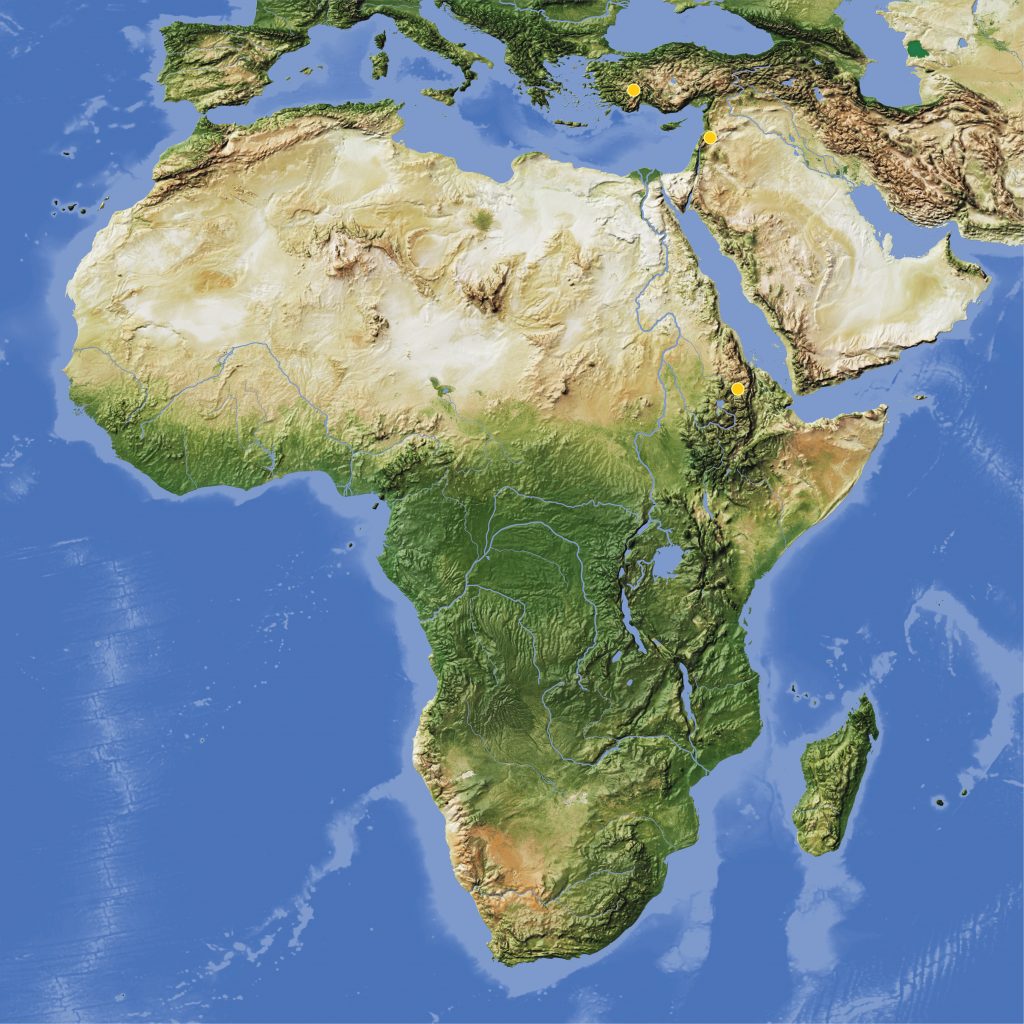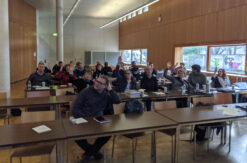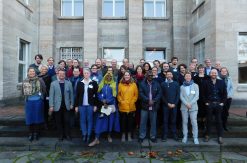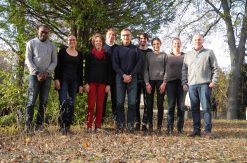ClimCellMed (Heinrich, Ingo)
Climate dynamics during the late Holocene derived from cell structure measurements of juniper trees in the eastern Mediterranean

Michael Schmeling, licensed under CC BY 4.0 international, waterbodies © OpenStreetMap contributers, modification by Johanna Sigl
Project description
Large parts of present-day Africa are affected severely by global and environmental change, resulting directly in or worsening already existing societal problems. Since the continent has gone through similar changes in the past, it is important to comprehend the regional past climate dynamics in more detail, since it has been hypothesised that environmental change played a significant role in conditioning human expansions, contractions and possibly even extinctions. More reliable regional climate reconstructions will be valuable background information when studying the transformations within human societies and entanglement mechanisms in Africa more comprehensively. In many parts of the world tree-ring based climate reconstructions have been accomplished successfully. African dendrochronology is often difficult because of indistinct, double, missing or wedging ring boundaries. In some instances, tree rings have been used as precisely dated high-resolution climate proxies. Long-term reconstructions derived from trees growing in Africa north of the equator are very rare, which we believe is a crucial gap in the palaeoclimate database. The future prospects for long tree-ring records in Africa north of the equator are generally bleak due to the very limited forested area. Dendroarchaeologically datable wood from African trees is very rare but dendroarchaeologically datable wood from timber (cedar, juniper and cypress) imported from Turkey is common. For dendroclimatological purposes, juniper imported from the Taurus Mountains off Turkey´s southern coast is seen as the most promising species in northern Africa. The main goal of the project is to combine woody juniper material from both living trees and archaeological sites, and to establish, for the first
time, a long reconstruction in the Mediterranean back to 3000 BC, utilizing a recently developed method applying confocal laser scanning microscopy for measuring cell structures of tree rings. The resulting cell structure chronologies will be subdivided into several classes, containing only a fraction of cell rows per tree-ring. The resulting sub-chronologies represent sub-seasonal cell growth patterns. Such sub-chronologies will be correlated with seasonal climate data and additional seasonal climate information will be derived. Subsequent analyses will examine relationships to the atmospheric and oceanic modes of climate variability (e.g., ENSO, NAO and Monsoon) in the eastern Mediterranean and northeast Africa, investigate the impact of past volcanic eruptions and identify possible climate effects on human societies in the region.
Project members
Applicant/Project director
Helmholtz Center Potsdam / GFZ German Research Center for Geosciences
heinrich@gfz-potsdam.de
Link:
https://www.gfz-potsdam.de/en/staff/ingo-heinrich/
![P08_Mansour Mdawar [Attribution: ; Copyright: ]](https://www.dainst.blog/entangled-africa/wp-content/uploads/sites/11/elementor/thumbs/P08_Mansour-Mdawar-scaled-ozkcghvo1ys4vhl32rxft98uahrgx0lykv6ahkc0zk.jpg)
PhD candidate
Helmholtz Center Potsdam / GFZ German Research Center for Geosciences
mdawar@gfz-potsdam.de
Posts

Report on SPP Entangled Africa Annual Meeting in Münster
Allgemein EN, P01 Prehistoric Axes EN, P02 Connecting Foodways EN, P03 InterLINK EN, P04 Lake Chad EN, P05 Landscapes EN, P06 DeGreening EN, P07 Routes of Interaction EN, P08 ClimCellMed EN, P09 Borrowed words EN, P10 Congo Basin EN, P11 FDM EN, P12 Coordination, P13 Tracing Connections EN![[Attribution: unknown; Copyright: not defined] D-DAI-KAAK-2024-JS-0063-PlanetAfrica_Eroeffnung_BER](https://www.dainst.blog/entangled-africa/wp-content/uploads/sites/11/2024/12/D-DAI-KAAK-2024-JS-0063-PlanetAfrica_Eroeffnung_BER-scaled-e1734001679313-247x163.jpg)
“Planet Africa” in the James Simon Gallery: Exhibition Opening and Press Reviews
Allgemein EN, P01 Prehistoric Axes EN, P02 Connecting Foodways EN, P03 InterLINK EN, P04 Lake Chad EN, P05 Landscapes EN, P06 DeGreening EN, P07 Routes of Interaction EN, P08 ClimCellMed EN, P09 Borrowed words EN, P10 Congo Basin EN, P11 FDM EN, P12 Coordination, P13 Tracing Connections EN
SPP Annual Meeting 2024 in Cologne
Allgemein EN, P01 Prehistoric Axes EN, P02 Connecting Foodways EN, P03 InterLINK EN, P04 Lake Chad EN, P05 Landscapes EN, P06 DeGreening EN, P07 Routes of Interaction EN, P08 ClimCellMed EN, P09 Borrowed words EN, P10 Congo Basin EN, P11 FDM EN, P12 Coordination, P13 Tracing Connections EN![[Attribution: ; Copyright: ] KAAK-SPP2143-TN-2023_Jahrestagung_Frankfurt_01-2022-8](https://www.dainst.blog/entangled-africa/wp-content/uploads/sites/11/2023/01/KAAK-SPP2143-TN-2023_Jahrestagung_Frankfurt_01-2022-8-247x163.jpg)
SPP Annual Meeting at the Goethe-University Frankfurt from 16th to 17th January
Allgemein EN, P01 Prehistoric Axes EN, P02 Connecting Foodways EN, P03 InterLINK EN, P04 Lake Chad EN, P05 Landscapes EN, P06 DeGreening EN, P07 Routes of Interaction EN, P08 ClimCellMed EN, P09 Borrowed words EN, P10 Congo Basin EN, P11 FDM EN, P12 Coordination, P13 Tracing Connections EN![[Attribution: J. Sigl; Copyright: Entangled Africa, KAAK] 2022-01-10_Teilnehmende07](https://www.dainst.blog/entangled-africa/wp-content/uploads/sites/11/2022/01/2022-01-10_Teilnehmende07-247x163.jpg)


![Daten & Folie: Mansour Mdawar, Projekt KlimZellMit [Attribution: J. Sigl; Copyright: KAAK] 2021-05-11_03](https://www.dainst.blog/entangled-africa/wp-content/uploads/sites/11/2021/06/2021-05-11_03-e1622808364550-247x163.jpg)
![[Attribution: ; Copyright: ] Jana_Eger_Satellitenbildauswertung_1](https://www.dainst.blog/entangled-africa/wp-content/uploads/sites/11/2020/03/Jana_Eger_Satellitenbildauswertung_1-247x163.jpg)
![[Attribution: ; Copyright: ] Jahresringe](https://www.dainst.blog/entangled-africa/wp-content/uploads/sites/11/2020/05/Jahresringe-247x163.jpg)

